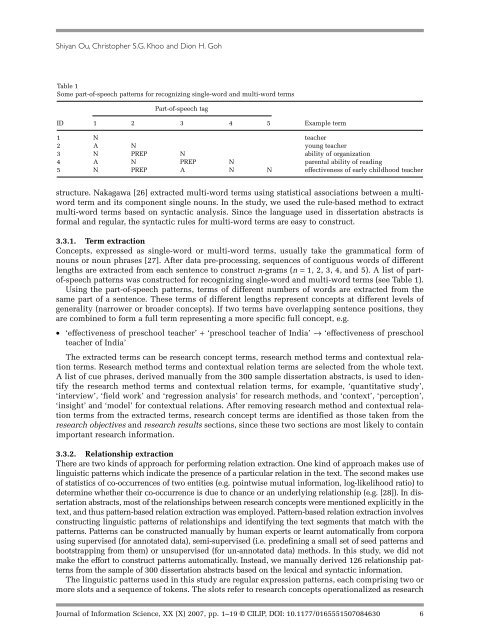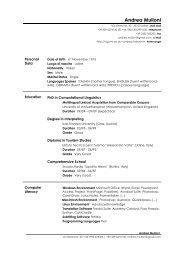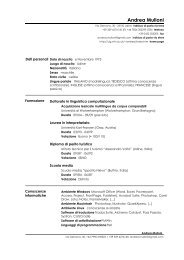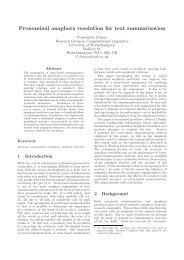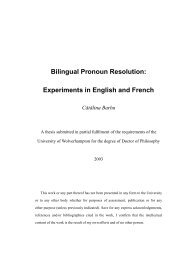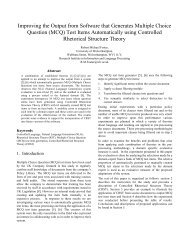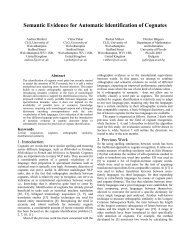Design and development of a concept-based multi ... - Citeseer
Design and development of a concept-based multi ... - Citeseer
Design and development of a concept-based multi ... - Citeseer
Create successful ePaper yourself
Turn your PDF publications into a flip-book with our unique Google optimized e-Paper software.
Shiyan Ou, Christopher S.G. Khoo <strong>and</strong> Dion H. Goh<br />
Table 1<br />
Some part-<strong>of</strong>-speech patterns for recognizing single-word <strong>and</strong> <strong>multi</strong>-word terms<br />
Part-<strong>of</strong>-speech tag<br />
ID 1 2 3 4 5 Example term<br />
1 N teacher<br />
2 A N young teacher<br />
3 N PREP N ability <strong>of</strong> organization<br />
4 A N PREP N parental ability <strong>of</strong> reading<br />
5 N PREP A N N effectiveness <strong>of</strong> early childhood teacher<br />
structure. Nakagawa [26] extracted <strong>multi</strong>-word terms using statistical associations between a <strong>multi</strong>word<br />
term <strong>and</strong> its component single nouns. In the study, we used the rule-<strong>based</strong> method to extract<br />
<strong>multi</strong>-word terms <strong>based</strong> on syntactic analysis. Since the language used in dissertation abstracts is<br />
formal <strong>and</strong> regular, the syntactic rules for <strong>multi</strong>-word terms are easy to construct.<br />
3.3.1. Term extraction<br />
Concepts, expressed as single-word or <strong>multi</strong>-word terms, usually take the grammatical form <strong>of</strong><br />
nouns or noun phrases [27]. After data pre-processing, sequences <strong>of</strong> contiguous words <strong>of</strong> different<br />
lengths are extracted from each sentence to construct n-grams (n = 1, 2, 3, 4, <strong>and</strong> 5). A list <strong>of</strong> part<strong>of</strong>-speech<br />
patterns was constructed for recognizing single-word <strong>and</strong> <strong>multi</strong>-word terms (see Table 1).<br />
Using the part-<strong>of</strong>-speech patterns, terms <strong>of</strong> different numbers <strong>of</strong> words are extracted from the<br />
same part <strong>of</strong> a sentence. These terms <strong>of</strong> different lengths represent <strong>concept</strong>s at different levels <strong>of</strong><br />
generality (narrower or broader <strong>concept</strong>s). If two terms have overlapping sentence positions, they<br />
are combined to form a full term representing a more specific full <strong>concept</strong>, e.g.<br />
• ‘effectiveness <strong>of</strong> preschool teacher’ + ‘preschool teacher <strong>of</strong> India’ → ‘effectiveness <strong>of</strong> preschool<br />
teacher <strong>of</strong> India’<br />
The extracted terms can be research <strong>concept</strong> terms, research method terms <strong>and</strong> contextual relation<br />
terms. Research method terms <strong>and</strong> contextual relation terms are selected from the whole text.<br />
A list <strong>of</strong> cue phrases, derived manually from the 300 sample dissertation abstracts, is used to identify<br />
the research method terms <strong>and</strong> contextual relation terms, for example, ‘quantitative study’,<br />
‘interview’, ‘field work’ <strong>and</strong> ‘regression analysis’ for research methods, <strong>and</strong> ‘context’, ‘perception’,<br />
‘insight’ <strong>and</strong> ‘model’ for contextual relations. After removing research method <strong>and</strong> contextual relation<br />
terms from the extracted terms, research <strong>concept</strong> terms are identified as those taken from the<br />
research objectives <strong>and</strong> research results sections, since these two sections are most likely to contain<br />
important research information.<br />
3.3.2. Relationship extraction<br />
There are two kinds <strong>of</strong> approach for performing relation extraction. One kind <strong>of</strong> approach makes use <strong>of</strong><br />
linguistic patterns which indicate the presence <strong>of</strong> a particular relation in the text. The second makes use<br />
<strong>of</strong> statistics <strong>of</strong> co-occurrences <strong>of</strong> two entities (e.g. pointwise mutual information, log-likelihood ratio) to<br />
determine whether their co-occurrence is due to chance or an underlying relationship (e.g. [28]). In dissertation<br />
abstracts, most <strong>of</strong> the relationships between research <strong>concept</strong>s were mentioned explicitly in the<br />
text, <strong>and</strong> thus pattern-<strong>based</strong> relation extraction was employed. Pattern-<strong>based</strong> relation extraction involves<br />
constructing linguistic patterns <strong>of</strong> relationships <strong>and</strong> identifying the text segments that match with the<br />
patterns. Patterns can be constructed manually by human experts or learnt automatically from corpora<br />
using supervised (for annotated data), semi-supervised (i.e. predefining a small set <strong>of</strong> seed patterns <strong>and</strong><br />
bootstrapping from them) or unsupervised (for un-annotated data) methods. In this study, we did not<br />
make the effort to construct patterns automatically. Instead, we manually derived 126 relationship patterns<br />
from the sample <strong>of</strong> 300 dissertation abstracts <strong>based</strong> on the lexical <strong>and</strong> syntactic information.<br />
The linguistic patterns used in this study are regular expression patterns, each comprising two or<br />
more slots <strong>and</strong> a sequence <strong>of</strong> tokens. The slots refer to research <strong>concept</strong>s operationalized as research<br />
Journal <strong>of</strong> Information Science, XX (X) 2007, pp. 1–19 © CILIP, DOI: 10.1177/0165551507084630 6


